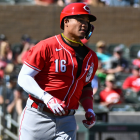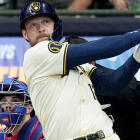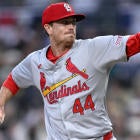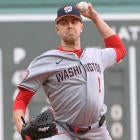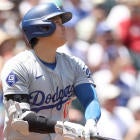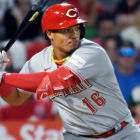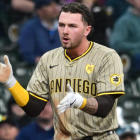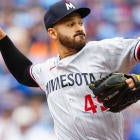Gauging depth at a position isn't so difficult when you know which players are good.
|
|
|
Tiering is a method of doctoring positional rankings so that players
of similar value are bundled into groups. A new group begins
whenever the next player down in the rankings has a vastly different
projected outcome from the player preceding him. Reducing a position
to five or six tiers instead of 30 or more individuals gives you a
blueprint to follow as your league's draft unfolds. Naturally, the
position to target is the one whose active tier is closest to
completion. -- Scott White |
But what if you don't? What if a position offers so many with a history of disappointment and so many others with no history at all that distinguishing the good from the not so good feels almost like guesswork?
Third base is in a period of transition. As the mainstays at the position become older and more injury prone, the next wave of talent races to close the gap.
So is it a weak position? Certainly not compared to second base or shortstop. Is it a strong position? Well, that all depends on how you assess the second and fifth tiers -- on how trustworthy you consider The Near Elite to be and how close you believe The Last Resorts are to replacing them.
The Elite: Miguel Cabrera
The Near Elite: Evan Longoria, Adrian Beltre, Ryan Zimmerman, Hanley Ramirez, David Wright, Chase Headley
The Next Best Things: Aramis Ramirez, Pablo Sandoval, Martin Prado, Brett Lawrie
The Fallback Options: David Freese, Kyle Seager, Will Middlebrooks
The Last Resorts: Pedro Alvarez, Mike Moustakas, Kevin Youkilis, Todd Frazier, Manny Machado
The Leftovers: Alex Rodriguez, Jedd Gyorko, Michael Young, Trevor Plouffe, Matt Carpenter, Chris Nelson, Chris Johnson, Nick Castellanos, Josh Donaldson, Juan Francisco, Lonnie Chisenhall
For me, the answers are "still pretty trustworthy" and "not especially close," which means I see third base as a top-heavy, not so deep position.
So then, my approach to the position on Draft Day shouldn't surprise you: accept nothing less than The Near Elite.
Really, I don't understand why anyone would approach it differently. The tier is six deep, so you shouldn't have to sacrifice much to get in on it. If you focus on other positions first (and you should, precisely because the tier is so deep), you'll still be able to snag one of those third basemen in the fourth or fifth round, after just about all of The Elite and The Near Elite have gone off the board at other positions.
And it's a good tier. Granted, none of those players compares to Cabrera, but comparing anyone to the first Triple Crown winner in 45 years is unfair. In a best-case scenario, each of those six is capable of numbers that would be elite at just about any other position.
But I suppose if you get sidetracked by pitching early, The Near Elite could easily pass you by. Or heck, maybe you genuinely don't want one of the six because you don't foresee a best-case scenario for him. Maybe, for example, Zimmerman's numbers over the last two years have you thinking he's not the same player he was in 2009 and 2010. Considering a cortisone shot in his balky shoulder propelled him to a .321 batting average and .967 OPS over his final 90 games last year, I disagree, but you're entitled to your opinion. I don't have the technology to visit the future and prove you wrong.
Likewise, Longoria has been banged up for a couple years now. Beltre is on the verge of his 34th birthday. Hanley Ramirez is just getting by even with shortstop eligibility. Wright hasn't been much of a power hitter since the Mets moved to Citi Field. Headley only became a power hitter last year. You have an excuse for each of them if you want to make one.
But do you? Though the position offers some reasonably good middle- and late-round alternatives, the risk only increases as you move down the ladder. Truthfully, Aramis Ramirez and Sandoval probably have about the same upside as the six players in the The Near Elite, but for one reason or another, they're less likely to meet it. Ramirez is a year older than Beltre and has proven to be the more susceptible to injuries in recent years, and Sandoval's endless weight issues jeopardize both his health and productivity.
After them and the steady-but-unspectacular Prado is where that next wave of talent begins. Lawrie and Seager stand out from Alvarez, Moustakas, Frazier and Machado because they offer some measure of speed, with Lawrie getting an additional bump because his upside is perceived to be the highest. That distinction mostly just applies to Rotisserie leagues, though. In Head-to-Head play, the power-speed combination isn't as big of a deal.
And then there's Middlebrooks, who has less than a full year under his belt. Between that and his poor plate discipline, you might say he's just as flawed as any of The Last Resorts, but ... eh, I just like him a little more. Unlike Moustakas, he's already proven his viability in the majors, and unlike Frazier, he doesn't have to worry about a journeyman-loving manager finding some Miguel Cairo type to start over him.
The Last Resorts, flawed as they may be, really are your last line of defense at this position. You won't find much productivity among the remains, unless you hope for an Alex Rodriguez sighting in the second half. Gyorko and Castellanos are both prospects who could get a shot at some point this season, and Chisenhall is a former prospect finally in line for everyday at-bats. But for the most part, The Leftovers are players you just plain don't want.
Stay in touch with the most passionate Fantasy staff in the business by following us on Twitter @CBSFantasyBB or Scott White at @CBSScottWhite . You can also e-mail us at fantasybaseball@cbsinteractive.com .








